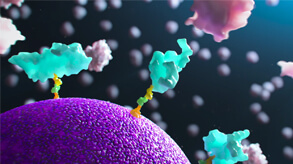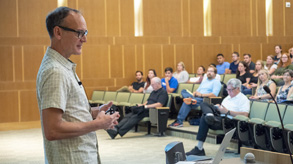What can proteomics teach us about infectious disease
ABSTRACT
Dr. Coomb’s group has used the SomaScan® Assay to screen >1,300 host proteins in Zika virus-infected cells, both globally and specifically in the central nervous system. Significant findings include the identification of nearly 300 astrocyte proteins that were significantly dysregulated by Zika infections, pointing to pathways that may be involved in neurological complications resulting from Zika, such as microcephaly and Guillain-Barré syndrome.
Dr. Coombs’ work in influenza has included extensive proteomic scanning of H5N1, H1N1, and H7N9 in various cell types including induced-pluripotent stem cells. Significant findings include the observation that low-pathogenicity strains induce less profound changes to the global proteome. For instance, avian strains stimulate significant downregulation of key proteins, including those involved in antimicrobial response. Seasonal strains do not elicit the same response. Further, Dr. Coombs’ team found that viral infection in stem cells can reduce pluripotency, activate autophagy, and lead to abnormal differentiation.
Key highlights include:
- Using proteomics to identify biological processes associated with infection
- Measuring proteomic changes in response to antimicrobials
- Comparing and contrasting cellular response to Zika and influenza
- Exploring how the SomaScan Assay could be used to study COVID-19

Kevin Coombs, Ph.D.
Professor of Medical Microbiology with cross-appointments in Physiology, Pathophysiology, and Microbiology the University of Manitoba
Dr. Kevin Coombs is a Professor in the Department of Medical Microbiology with cross-appointments in Physiology and Pathophysiology and in Microbiology. He serves on several Cell Biology, Molecular Biology, and Virology Editorial Boards and is currently Chair of the CIHR Virology & Viral Pathogenesis Committee.
Dr. Coombs received his B.A.s in Biology and English from the State University of New York in Geneseo and his M.A. and Ph.D. from the University of Texas in Austin. His post-doctoral training in molecular and structural virology was done in the labs of Drs. Bernie Fields and Steve Harrison at Harvard.
His research interests include delineation of the protein and nucleic acid interactions in nucleoprotein complexes, using a variety of RNA viruses as models. His lab studies how these interactions change as a result of, and in turn, are modulated by, conformational transitions that occur during macromolecular assembly and disassembly, how these processes can be attenuated by anti-viral compounds, and how these processes in virus infections contribute to pathogenesis in the host.
What can proteomics teach us about infectious disease
A presentation by Kevin Coombs, Ph.D.
More webinars
WebinarProteomics in Clinical Trials: Lessons from Semaglutide Treatment in Individuals with Obesity
Advancements in proteomic profiling have opened new avenues for understanding the complex mechanisms underlying obesity and its comorbidities. By measuring thousands of proteins at once, researchers gain a comprehensive view of an individual’s metabolic health, revealing subclinical processes and pinpointing potential therapeutic targets.
WebinarPathways to Digital Health: AI and Omics in Rheumatoid Arthritis
Explore how groundbreaking proteomic research is transforming our understanding of rheumatoid arthritis (RA). In this on-demand webinar, Allan Stensballe, PhD, shares new insights into the molecular landscape of RA-affected synovial tissue, revealing how autoantibodies and protein signatures may hold the key to more precise personalized therapies.
WebinarUsing Antibody Profiling to Identify Novel Diagnostic Biomarkers
Current cancer screening methods often lead to false positives, false negatives and invasive biopsies that lack prognostic insights. Emerging research suggests that cancer-specific IgM and IgG antibodies – produced by B cells upon recognizing malignant cells – could serve as stable, easily measurable blood biomarkers for detecting and monitoring high-incidence cancers like melanoma and breast, prostate, bowel, lung and pancreatic cancer. This approach has the potential to improve early diagnosis, reduce uncertainty and enhance treatment planning.





